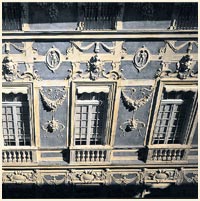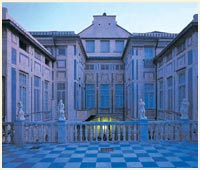When observing the areas during the survey to verify the level of deterioration, the non-uniform nature of the plaster was immediately noticed, extremely impoverished by atmospheric agents, except in the zones protected by eaves and string courses, where the painted decoration could still be seen in a well preserved state; the base was found to be covered by hydraulic mortar and sand (with inclusions of different kind and grain size), and by thinner layer of powdered terracotta, also confirmed later by scientific tests.
The plaster, spread over scaffold after scaffold by the days, caused a residual pictorial film, very compact, with lime based colours, spread on a base which was still quite fresh, (strips of decoration and colour present in the areas protected from the washing away).
A lot of stuccoing and plugging in cement mortar was found, at times covering large areas, carried out in different periods during the life time of the building.
The evidence of one of these interventions is certified by the date written on a moulding below the eaves of the façade of the entrance (1868), found on the strip decorated with a black and white stencil, covered with a yellow colouring: obviously 'maintenance' commissioned by the Podestà.
Due to the weathering and the presence of the incorrect mixture of restoration base elements, the layering and the thickness of the base was not uniform: the first operation was to remove all the parts rebuilt with unsuitable mortar, and to see to its consolidation in depth, then to reintegrate any gaps with lime based mortar and finally to plaster with crushed terracotta where it was necessary.
Contemporarily, to be able to revise the entire painted décor and its beautiful scenery, a survey was carried out of all the lines of incision that were present, first on the site and then using graphics, what is more these lines were very evident by looking closely or with the use of grazing lights.
The entire decorative display, which came to life using a sprinkling of lime based colours, all correctly pigmented, had its surface treated, for protection, with a siloxanic water-repellent.
Likewise the operations carried out on the surfaces of the façade overlooking Palazzo Grimaldi (Tursi): here all of the decorations were re-done following the marks inscribed in the plaster, documented by the historical photo tracked down at the photography studio in Palazzo Rosso.


